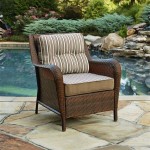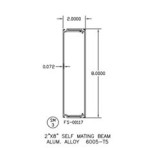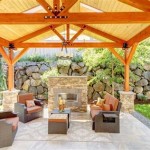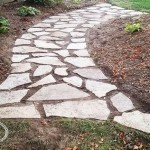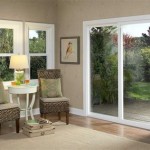```html
Enhancing Outdoor Living: A Comprehensive Guide to Grill and Patio Design
The integration of a grill and patio space represents a significant investment in enhancing outdoor living. These areas extend the functional space of a residence, providing venues for socializing, relaxation, and culinary experiences. Thoughtful planning and execution are crucial to creating a harmonious and functional outdoor environment that meets the specific needs and aesthetic preferences of the homeowner.
This article aims to provide a comprehensive overview of key considerations in grill and patio design, encompassing various aspects from initial planning and material selection to equipment choices and landscaping integration. The objective is to equip readers with the knowledge necessary to create an outdoor living space that is both aesthetically pleasing and highly functional.
Planning and Design Considerations for Grill and Patio Spaces
Effective planning forms the foundation of a successful grill and patio project. Before commencing any construction or purchasing equipment, careful consideration of several key factors is essential.
First, assess the available space. The dimensions of the patio area will directly influence the size and type of grill that can be accommodated, as well as the layout of seating and dining arrangements. Consider the proximity of the patio to the house, particularly the kitchen, to streamline food preparation and transportation. A patio located close to the kitchen minimizes the distance for carrying food and supplies, enhancing convenience.
Second, determine the intended use of the space. Will the patio primarily be used for intimate family gatherings, large-scale entertaining, or a combination of both? The anticipated frequency and scale of use will inform decisions regarding grill size, seating capacity, and the inclusion of additional features, such as outdoor bars or kitchens. If large gatherings are anticipated, a larger grill and ample seating will be necessary.
Third, evaluate the existing site conditions. Consider factors such as sun exposure, prevailing wind direction, and drainage. Areas with excessive sun exposure may require shading solutions, such as pergolas or awnings. Windbreaks, such as strategically placed shrubs or walls, can mitigate the impact of strong winds, creating a more comfortable environment. Proper drainage is crucial to prevent water accumulation and potential damage to the patio surface. Furthermore, consider the view from the patio and make sure your design enhances it. If the view is undesirable, landscaping or other architectural elements should be used to obscure or improve it.
Fourth, establish a budget. Determine the total amount of money available for the project and allocate funds to different components, such as patio construction, grill purchase, furniture, landscaping, and lighting. Sticking to a budget will often require making strategic compromises and prioritizing essential features.
Fifth, develop a detailed design plan. This plan should include a scaled drawing of the patio area, indicating the placement of the grill, seating, dining table, and any other desired features. The plan should also specify the materials to be used for the patio surface, grill surround, and other elements. This plan serves as a roadmap for the project and helps to ensure that all elements are integrated harmoniously.
Material Selection for Patio Surfaces and Grill Surrounds
The selection of materials for the patio surface and grill surround is a critical aspect of the design process. The chosen materials should be durable, aesthetically pleasing, and compatible with the overall design aesthetic.
Concrete is a popular choice for patio surfaces due to its versatility, durability, and affordability. It can be poured in various shapes and sizes and can be stained, stamped, or textured to create a wide range of visual effects. Stamped concrete can mimic the look of more expensive materials, such as brick or stone, at a lower cost. Concrete is also relatively low-maintenance, requiring only occasional cleaning.
Pavers offer another viable option for patio surfaces. They are available in a variety of materials, including brick, concrete, and stone. Pavers provide a more modular and customizable look and can be easily replaced if damaged. They also offer good drainage, as water can seep between the individual pavers. However, paver installation can be more labor-intensive than pouring concrete.
Natural stone, such as flagstone, bluestone, and travertine, provides a more upscale and natural look. Stone is highly durable and weather-resistant, and it offers a unique and aesthetically pleasing surface. However, natural stone can be more expensive than concrete or pavers, and installation may require specialized skills. It is also important to seal natural stone to protect it from staining and water damage.
For grill surrounds, materials must be heat-resistant and durable. Brick and stone are commonly used for this purpose. Brick provides a classic and traditional look, while stone offers a more rustic and natural aesthetic. Stainless steel is another option, particularly for contemporary designs. Stainless steel is easy to clean and maintain, but it can become hot to the touch in direct sunlight.
Wood is generally not recommended for grill surrounds due to its flammability. However, it can be used for decorative elements, such as trim or accents, provided that it is properly treated with a fire-retardant coating.
Selecting the Appropriate Grill and Essential Accessories
The grill is the centerpiece of any outdoor cooking area, and selecting the right grill is essential for ensuring a satisfying grilling experience. Consider the size and type of grill that best suits your cooking needs and preferences.
Gas grills are the most popular type of grill due to their convenience and ease of use. They heat up quickly and offer precise temperature control. Gas grills are available in a wide range of sizes and configurations, from small portable grills to large built-in models. Propane gas grills are more portable, while natural gas grills require a gas line connection to the house.
Charcoal grills offer a more traditional grilling experience and impart a smoky flavor to food. They require more skill and attention to maintain proper temperature, but many grilling enthusiasts prefer the taste of charcoal-cooked food. Charcoal grills can be either kettle-style or kamado-style. Kettle-style grills are relatively inexpensive and versatile, while kamado-style grills are more expensive but offer superior heat retention and temperature control.
Pellet grills use wood pellets as fuel, combining the convenience of gas grills with the smoky flavor of charcoal grills. They offer precise temperature control and can be used for both grilling and smoking. Pellet grills are generally more expensive than gas or charcoal grills.
Built-in grills are designed to be integrated into an outdoor kitchen or grill surround. They offer a more seamless and integrated look and are often equipped with additional features, such as side burners, warming drawers, and rotisseries. Built-in grills are more expensive than freestanding grills and require professional installation.
In addition to the grill itself, several accessories can enhance the grilling experience. A grill cover is essential for protecting the grill from the elements. Tongs, spatulas, and brushes are necessary for handling food and cleaning the grill. A meat thermometer is crucial for ensuring that meat is cooked to the desired temperature. A grill brush is essential to keep the grill grates clean, which helps prevent food from sticking. Consider purchasing a set of grilling tools to have all the necessary implements on hand.
Outdoor lighting is a vital component of any patio design, particularly for evening use. Incorporate a variety of lighting options, such as string lights, pathway lights, and spotlights, to create a warm and inviting ambiance. Consider using dimmable lights to adjust the brightness level as needed. Solar lights are energy-efficient and easy to install, while hardwired lights offer more reliable and consistent performance.
Landscaping plays a crucial role in integrating the grill and patio into the overall outdoor environment. Plant trees, shrubs, and flowers to create a visually appealing and relaxing space. Consider using plants that attract pollinators, such as bees and butterflies. Mulch around plants to retain moisture and suppress weeds. Install a sprinkler system to automate watering and ensure that plants receive adequate hydration.
Adequate seating is essential for creating a comfortable and inviting patio space. Choose seating that is appropriate for the intended use of the patio. For dining, consider a table and chairs that are sized appropriately for the number of people you typically entertain. For lounging, consider comfortable chairs, sofas, or daybeds. Choose furniture that is weather-resistant and easy to clean. Cushions and pillows can add comfort and style to outdoor furniture.
Finally, consider any necessary permits or regulations before commencing construction. Check with your local municipality to determine whether any permits are required for building a patio or installing a grill. Complying with all applicable regulations will help to avoid potential fines or delays.
```
13 Upgrades To Make Over Your Outdoor Grill Area

7 Simple Tips For Organizing Outdoor Grill Area

Large Brick Patio Design With Grill Station Bar Able Plan Mypatiodesign Com

Grill Patio Burger Joint

Allan Block Photo Gallery Project Ideas And More Backyard Kitchen Outdoor Design Built In Grill

Photos At Grill Patio Harbour City 25 Visitors

The New Grill Cart Patio Extension Love Renovations

44 Creative Built In Grill Ideas For Outdoor Cooking 2024 Backyard Grilling Spaces Patio Designs

This Popular Restaurant In Kota Kinabalu Lets You Fix Your Grilled Food Cravings Kl Foodie

Grill Station With Bar Design R60 Mypatiodesign Com
Related Posts

